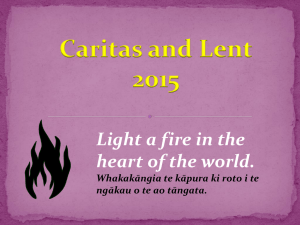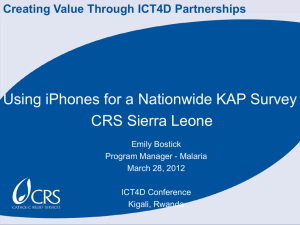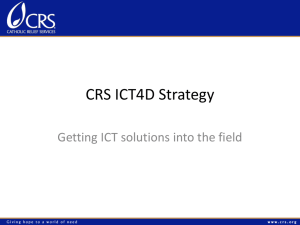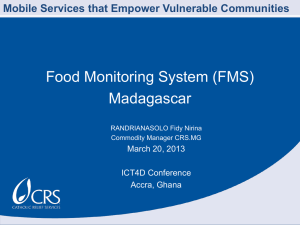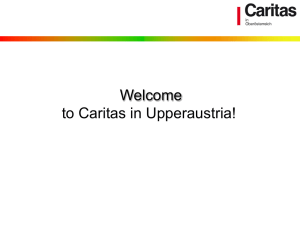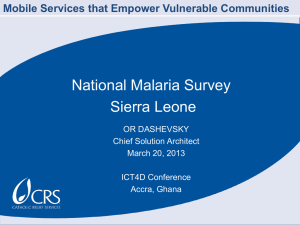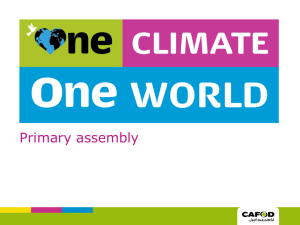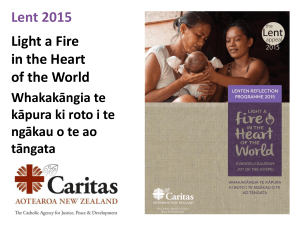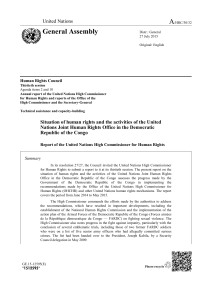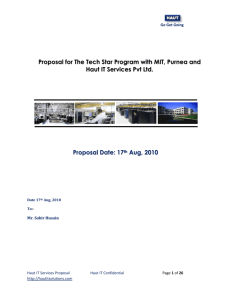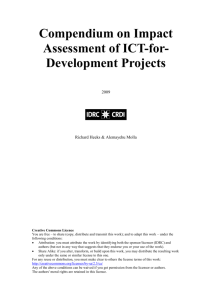Early warning and community protection
advertisement
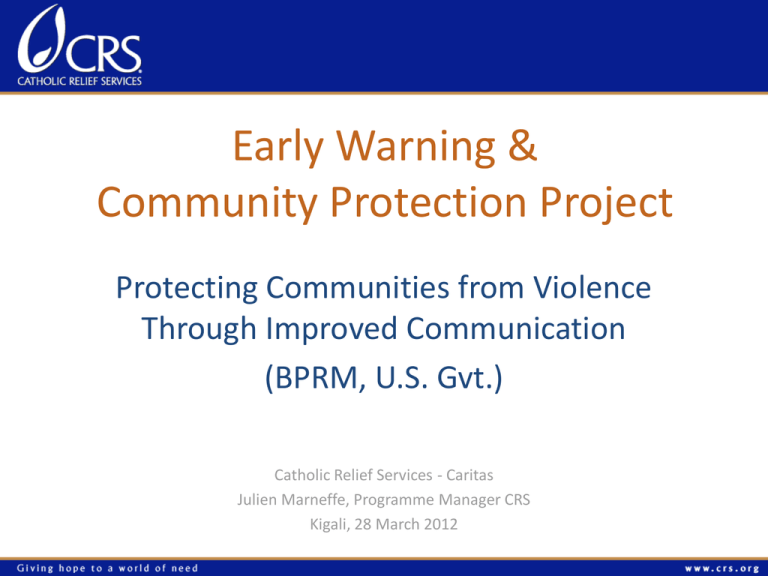
Early Warning & Community Protection Project Protecting Communities from Violence Through Improved Communication (BPRM, U.S. Gvt.) Catholic Relief Services - Caritas Julien Marneffe, Programme Manager CRS Kigali, 28 March 2012 Project Background • Emergency • ICT4D to enhance community-based protection • Partnerships – NGO: 4 diocesan Caritas (see below) – GOVT: indirectly through MONUSCO/Civil Affairs – Private sector: AIRTEL (cell-phone network provider) Project Goal Provide the civilian populations of 40 isolated communities (about 250,000 people) in Eastern DRC with increased capacity to: Mitigate the impact of violence associated with the presence of armed groups Send regular monitoring information and alerts on the humanitarian and security situation to receive timely and quality assistance from protection actors 1 Partners Map ORIENTALE (HAUT UELE) 1. Dungu-Doruma 2. Isiro SOUTH KIVU 3. Bukavu + Shabunda 4. Uvira 2 DUNGU BUKAVU 3 4 UVIRA Context in the Kivus and Haut Uele Various armed actors threatening and preying on the civilian population: FDLR, Mai-Mai and other “selfdefense groups”, (ex-)CNDP, LRA,… Attacks for supplies, abduction of children and women, reprisal, or to control the land by instigating fear and forced displacements Widespread sexual violence Context in the Kivus and Haut Uele Lack of government presence/control, corruption and impunity Congolese security forces - Army (FARDC), police (PNC) and intelligence agency (ANR) are responsible for 50% protection incidents and abuses against civilians Limited capacity and presence of humanitarians and MONUSCO – particularly in Haut Uele Project Overview 2 STRATEGIC APPROACHES: 1. Developing Community-based protection structures 2. Developing an emergency communications system as part of an Early Alert and Response System (EARS) Early Warning & Community Protection 1. Local Committee PROTECTION PLAN 2. COMMUNITY ACTION PLAN 3. EARS Early Alert and Response System 1. Local Committee PROTECTION PLAN 2. COMMUNITY ACTION PLAN 3. EARS The Choice for ICT4D ISSUE TO ADDRESS: • Communities isolation – vulnerable to armed groups • Poor state of roads and communication infrastructures • Protection actors without timely information on humanitarian and security situation • Example: LUVUNGI The Choice for ICT4D ICT4D SOLUTION: Create an emergency communication system between isolated and vulnerable communities and protection actors • Using cell-phones where cell-phone network existing (3/40 communities) • Using HF where no network (37/40) ICT4D Solution (HF) Hardware: Barrett 2050 - Transceiver with dipole antenna - Powered by a solar panel and battery ICT4D Solution (HF) Advantage: allows communications for free Disadvantages: high cost of equipment & technical difficulties for users and maintenance Tech. Support: service provider installed HF and trained radio operators on use and maintenance Partnership: MONUSCO and Humanitarians (HCR, OCHA) HF-based EARS •Civil society +Caritas +FARDC & PNC +Congolese Gvt. ----Risk mapping, Action Planning Monitoring, Advocacy Community ? (37) Focal Point* ? ? CLA* (3) Reference Diocesan Caritas Point* Local Committee for Community Organization Community FARDC? PNC? Focal Point* (6) Humanitarian Focal Point* (12) MONUSCO Base (COB) OCHA/ UNHCR/ Protection Cluster Humanitarian Protection Actors ICT4D Solution (Cell-Phone) • Advantages: low cost, easy for users & allows EWS throughout community with several focal points • Disadvantages: dependent on cell-phone network quality; communications for a cost • Tech. Support: using ‘group sms’ options • Partnership: AIRTEL network provider (free communication within closed network) Cell-phone-based EARS MONUSCO Relay Points 1 2 4 5 7 8 3 COMMUNITY ‘A’ Focal Point 6 Diocesan Caritas Reference Point* 9 COMMUNITY ‘B’ ? Focal Point CLA* HUMANITARIAN PROTECTION ACTORS OCHA UNHCR/ Protection Cluster Emergency Cells Challenges (I) SAFETY • Staff on mission in areas with armed groups presence • HF-radio equipment • Do No Harm PROGRAMMATIC • Logistics – access despite poor road infrastructure • Benevolent participation of phones and radio operators • Dependence on external actors to respond to alerts • Loss of confidence by communities Challenges (II) TECHNICAL • Training villagers as radio operators • Weather • Maintenance of HF-radios PARTNERSHIP • AIRTEL – no-cost communication with Cell-phone EWS • MONUSCO – M.O.U. on response & maintenance • Caritas – sustainability (Diocesan Ref. Point & Maintenance) Lessons learned • Need strong logistics support • Need to develop intra-agency technical expertise with HF communications (and radio in general) • Communications/Alert Data management (iFormBuilder?) • System does address community isolation, and its vulnerability to the consequences of armed groups threats or violence • Contributes to increase agency competitiveness – Assist/facilitate needs assessments for future projects – Increase CRS visibility – Pilot project - developing CRS expertise in a new and cutting edge emergency & protection kind of projects Sustainability • Capacity – training local CRS/Caritas HF technicians • Support – develop agreement with MONUSCO CITS to assist CRS/Caritas on maintenance issues • Cost – making private (social or commercial) communications for a (low) cost in the villages • Addressing Needs – expanding system to new communities, already in Bas Uele (June 2011) and to North Kivu and Ituri • How partnerships help address issues – Caritas : ensure diocesan reference point after project ends – MONUSCO: assist Caritas and CRS with relations to Congolese government – AIRTEL : continue to provide cost free communications within EWS Impact of project • Reduced isolation of communities – Family talking through radio for first time in over a year – Opening access for other humanitarian organizations • Recent mass displacements from Shabunda – CLOC in 2 communities informed of mass arrival of IDPs – Information was then shared with Cluster, HCR and OCHA CONCLUSION Early Alert/Response System (EARS) cannot be implemented without partnerships for implementation, support and sustainability ICT4D in EARS project consists in using technology (HF radios & cell-phones) to empower and provide the tools necessary to address the protection needs of vulnerable civilian communities Questions & Answers THANK YOU
